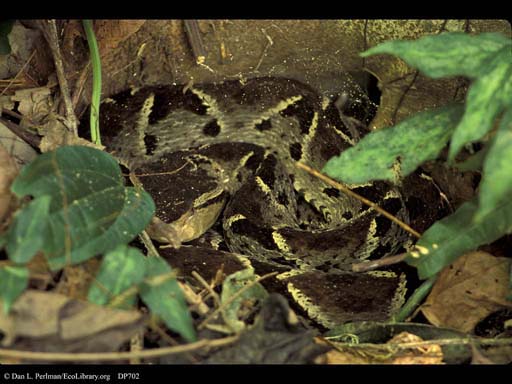Camouflaged snake closeup
| Title | Info |
|---|---|
| Common name | Fer-de-lance |
| Scientific name | Bothrops asper |
| Taxonomic group | Viperidae |
| Source | Dan L. Perlman |
| Ecological interactions | Predation |
| Selection and adaptations | Coloration |
| Coloration | Camouflage |
| Organisms | Animals |
| Animals | Reptiles |
| Lessons | Mimicry and Camouflage |
| Date | 1998 |
| Location | La Selva Biological Station,Costa Rica,North America |
Camouflaged fer-de-lance snake, Costa Rica. The fer-de-lance or terciopelo, as it is known in Costa Rica, is a deadly poisonous viper. These snakes can grow to more than 2 yd (2 m) in length, are quite aggressive, unlike most other vipers, and are extraordinarily well camouflaged. Like other pit vipers, their fangs stay folded up on the roof of the mouth until just before the strike, and they can deliver the better part of a cubic inch (several cubic centimeters) of venom. Their venom breaks down blood and muscle tissue, essentially beginning the process of digesting the prey even before it is swallowed. As with other pit vipers, these snakes have a pair of small heat-sensing organs near the fronts of their heads; these organs allow them to sense mammals moving nearby, even in the dark. This image shows the snake up close (the photographer used a long telephoto lens!). The two companion images show the snake from a greater distance where its camouflage is especially effective.
